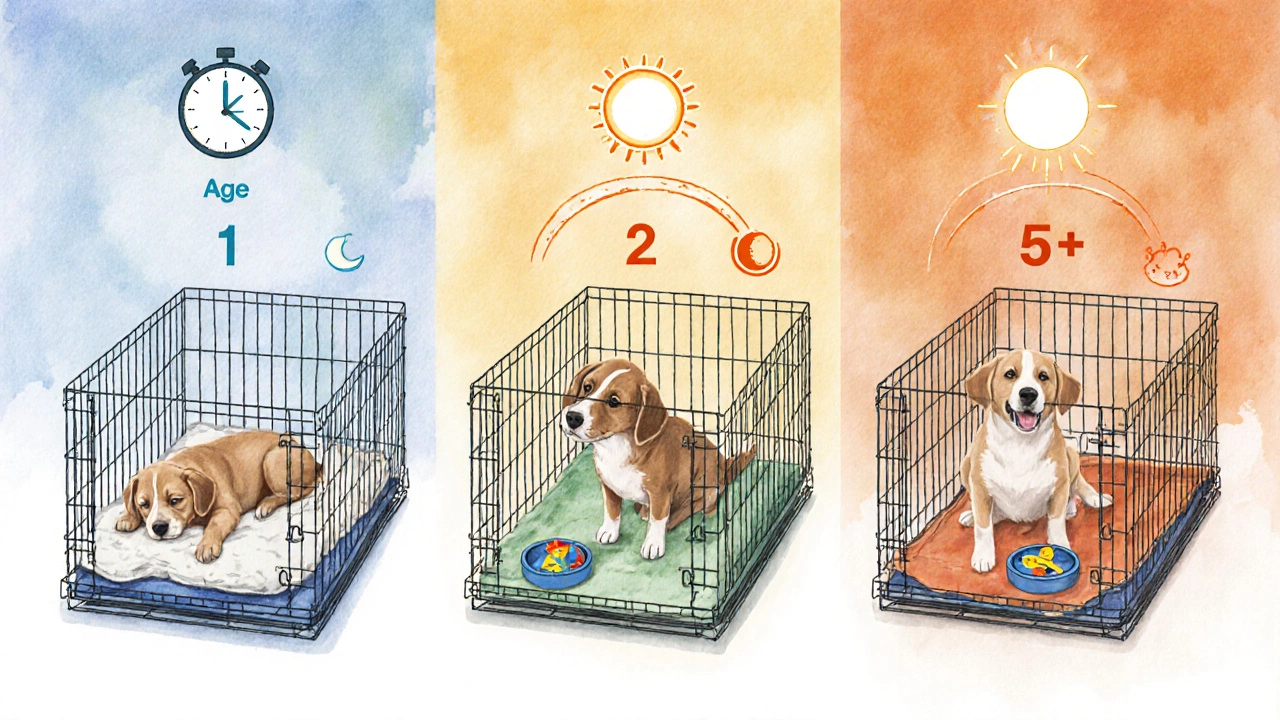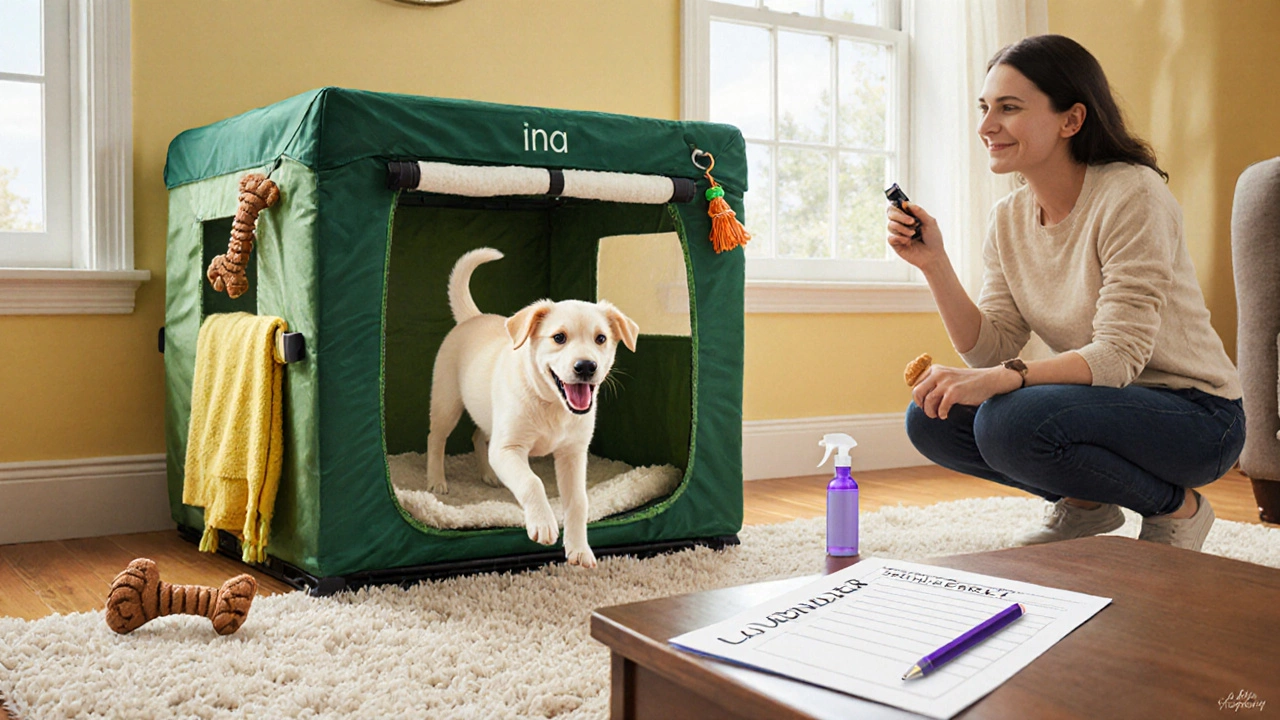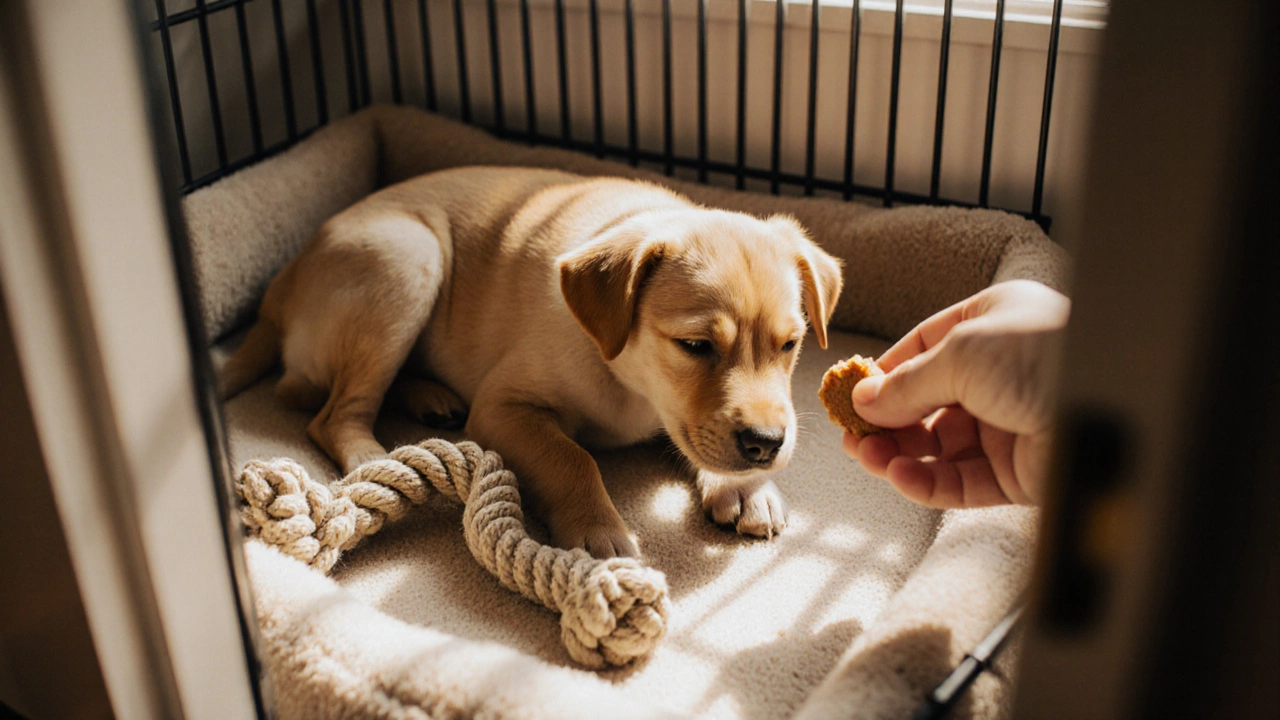Puppy Crate Time Calculator
Safe Crate Time Calculator
Enter your puppy's age and planned crate time to see if it's safe.
Wondering how many hours a day you can keep your new puppy in a crate without causing stress? It’s a common question for first‑time dog parents, and the answer isn’t a one‑size‑fits‑all number. The right amount depends on the pup’s age, energy level, and how you break up the time with play, meals, and bathroom breaks.
Why Crate Training Matters
Puppy crate training is a method that uses a safe, enclosed space to help a young dog learn house rules, feel secure, and develop independence. When done right, a crate becomes a den‑like retreat rather than a punishment.
What a Puppy Really Needs
Puppy development is rapid in the first six months. During this period, three core needs dictate how long a crate is tolerable:
- Sleep: Young pups can sleep 18-20 hours a day, often in short bursts.
- Bathroom breaks: Their bladders are tiny; a 10‑week puppy typically needs a potty trip every 1-2 hours.
- Social interaction: Play, training, and exposure to family members are crucial for confidence building.
If any of these needs are consistently denied, you’ll see whining, accidents, or even aggression.
Breakdown of Safe Crate Hours by Age
Below is a practical guideline that translates the needs above into daily crate limits. These ranges are backed by the American Kennel Club’s recommendations and observations from the K9 Training Institute.
| Age (weeks) | Maximum Continuous Hours | Suggested Total Daily Hours | Key Notes |
|---|---|---|---|
| 8-10 | 1-1.5 | 4-6 | Frequent potty breaks; use crate only for naps. |
| 10-14 | 2 | 6-8 | Introduce short “quiet time” sessions. |
| 14-18 | 3 | 8-10 | Start linking crate to bedtime routine. |
| 18-24 | 4 | 10-12 | Puppy can handle longer overnight stays. |
| 24+ | d>5+ | 12-14 | Most adult dogs comfortably spend half the day crated. |
These numbers are max recommendations; most owners find slightly lower totals keep the pup happier.

How to Spot an Over‑Crated Puppy
Watch for these red flags. If you notice two or more, trim the crate time immediately.
- Persistent whining or barking that doesn’t stop after a few minutes.
- Soiling the crate despite a regular bathroom schedule.
- Destructive chewing on the crate bars or door.
- Lethargy or over‑excitement when released.
- Signs of anxiety such as panting, drooling, or shaking.
Structuring Crate Time for a Happy Pup
- Morning session: After the first bathroom break, place the puppy in the crate for a short nap (20‑30 minutes). Use a chew‑safe toy to keep them occupied.
- Mid‑day break: Let the pup out for play, training, and a second bathroom trip. Aim for at least 30 minutes of active interaction.
- Afternoon session: Return to the crate for another short rest, especially if the puppy is tired after a walk.
- Evening wind‑down: Include the crate as part of the bedtime routine. Dim lights, a soft blanket, and a quiet environment signal that it’s time to settle.
- Overnight: Once the pup is 14 weeks old, an uninterrupted 4‑hour night stretch is usually safe. Gradually extend as the puppy matures.
Breaking up the day into several short periods mimics a natural den‑rest cycle and prevents the puppy from feeling isolated.
Making the Crate Comfortable (and Fun)
Comfort is more than a soft bed. Here are three tweaks that turn a plain crate into a pup‑friendly zone:
- Soft bedding: Choose a washable, chew‑resistant pad. The K9 Training Institute recommends a low‑loft foam that supports growing joints.
- Safety‑rated toys: A durable rope chew or a puzzle feeder keeps the mind engaged without risking choking.
- Calming scents: A few drops of lavender‑based pet spray (vet‑approved) can reduce anxiety during longer stays.
Remember, the crate should never replace real interaction. Use it as a supplement, not a substitute.

Common Mistakes and How to Avoid Them
Even well‑intentioned owners slip up. Below are the most frequent errors and quick fixes:
- Leaving the puppy for too long: Stick to the age‑based limits in the table above. Set alarms on your phone as reminders.
- Using the crate as punishment: Pair crate time with positive rewards-treats when the door opens, gentle praise, and a calm tone.
- Ignoring bathroom cues: Keep a notebook of feeding and potty times to anticipate needs.
- Choosing the wrong size crate: The crate should be tall enough for the puppy to stand and turn around, but not so large that they can eliminate in one corner and sleep in another. Measure from nose to tail tip and add a few inches.
- Neglecting socialization: Schedule daily outings, puppy‑play dates, and brief exposure to common household sounds.
Quick Checklist for Daily Crate Management
- ✓ Verify the crate size matches the puppy’s current height.
- ✓ Follow the age‑based maximum continuous hours.
- ✓ Offer a bathroom break before and after each crate session.
- ✓ Include a chew‑safe toy or puzzle feeder in the crate.
- ✓ Observe behavior for signs of stress and adjust accordingly.
Using this checklist each day helps you stay consistent and builds trust with your growing companion.
Frequently Asked Questions
Can I leave a 12‑week puppy in a crate overnight?
Yes, but limit the overnight stretch to 3‑4 hours. Wake up for a bathroom break around 2 am if the pup shows signs of needing to go.
How do I know if my puppy is getting enough exercise outside the crate?
A tired puppy will settle quickly after a short walk or play session. If they’re still hyperactive after 30‑45 minutes of activity, add another brief walk or interactive game.
Should I use a blanket or a mat inside the crate?
A washable, chew‑resistant mat is best. Blankets can be tempting to chew and may become a choking hazard as the puppy grows.
What’s the difference between crate training and confinement?
Crate training pairs the crate with positive reinforcement and scheduled breaks. Simple confinement often lacks structure and can feel punitive to the dog.
Can a puppy develop anxiety from being crated too much?
Absolutely. Chronic over‑crating can lead to separation anxiety, excessive barking, and even regressions in house‑training. Keep sessions short and always follow with positive interaction.
Is it okay to let a puppy chew on the crate bars?
Chewing is a natural behavior, but persistent biting of the bars can damage the crate and indicate boredom. Provide safe chew toys and ensure the crate isn’t the only outlet for oral fixation.
